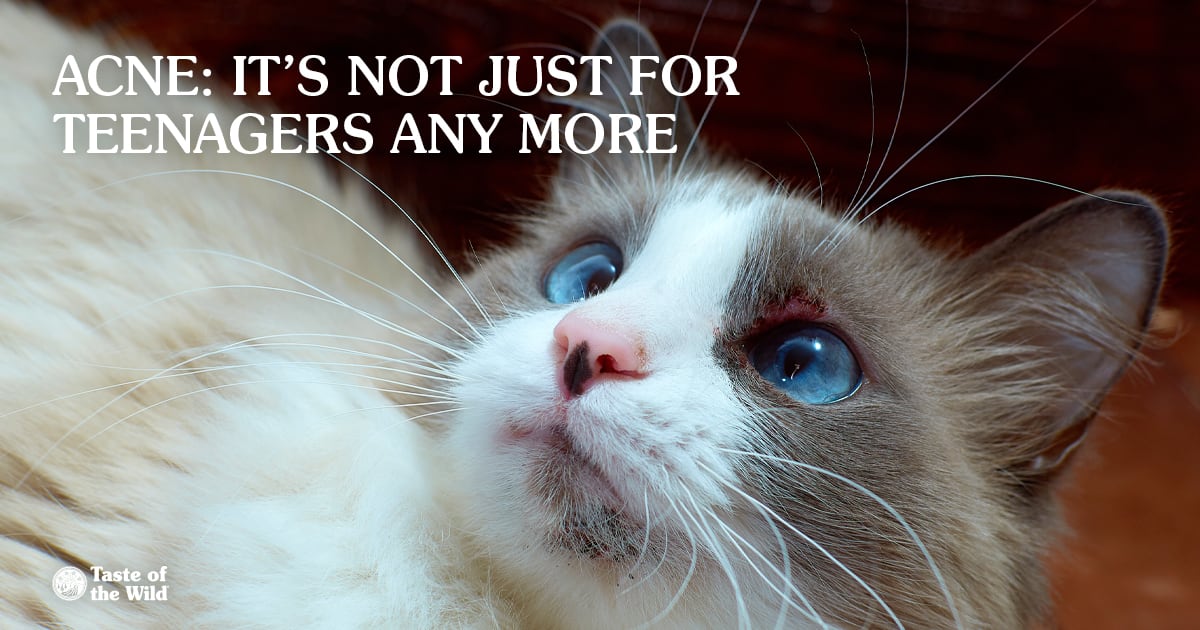
Oh, the embarrassment of those unsightly blemishes. While often the source of teenage angst in humans, acne doesn’t have the same social repercussions for cats. In fact, feline acne has nothing to do with a cat’s teenage years or hormonal roller coasters going on inside the body. So what’s the deal with acne in cats?
Feline acne is a skin condition that affects the chin and lips, including the lower lip, the corners where the lips meet, and less commonly, the upper lip. Hair follicles in these areas become plugged with oil and dead skin, leading to redness, irritation, blackheads or worse. Cats can experience this condition episodically or it can be a persistent problem.
Signs of feline acne
Early signs of feline acne include skin inflammation, blackheads, spotty hair loss, crusts and dark flecks of debris. Secondary bacterial or fungal infections can lead to worsening of signs, and plugged hair follicles can become filled with pus and rupture. The affected area can become swollen, itchy and painful, and hair loss may become more widespread. In chronic cases, skin scarring can occur.
What causes it?
Of course, we can’t blame these feline skin lesions on too many greasy French fries. But experts still aren’t clear what, exactly, causes the condition. Some blame poor grooming habits, stress or abnormal skin oil production. Others point to viral infections or a compromised immune system, which can lead to microscopic Demodex mites infiltrating the hair follicles. Other theories include underlying allergies to plastic food bowls, food or environmental irritants.
How to help your cat at home
Start by replacing any plastic food or water bowls with ceramic or stainless-steel bowls.
If your cat will tolerate it, gently soak the problem area with a washcloth dipped in warm water two or three times a day to help soften and remove crusts and open plugged hair follicles. Do not use any over-the-counter ointments or treatments intended for people.
When to see your veterinarian
If you don’t see any improvement, visit with your veterinarian. The doctor may suggest some diagnostic procedures. A skin scraping may be recommended to check for Demodex mites. They may also suggest a bacterial culture or fungal culture for ringworm. Sometimes, cats can develop a lesion on the lower jaw from tooth root abscesses, so a dental X-ray may be in order. Rarely, a skin biopsy may be recommended.
Treating feline acne
Gently shaving the area can make it easier to clean and enable topical medications, such as shampoos, ointments or wipes, to be applied directly to the skin. The doctor may recommend a topical treatment that helps flush the hair follicles or a medicated treatment to fight bacteria or fungal infections. In severe cases, he or she may prescribe oral medications or an injection to treat infections or help soothe inflammation.
Keeping your cat’s chin and the skin around the lips clean may help prevent outbreaks, but for many cats, the condition can flare periodically. If that happens, your veterinarian can provide guidance to help keep your cat comfortable.
RELATED POST: 12 Tips for Raising a Healthy, Happy Kitten
The information in this blog has been developed with our veterinarian and is designed to help educate pet parents. If you have questions or concerns about your pet's health or nutrition, please talk with your veterinarian.
